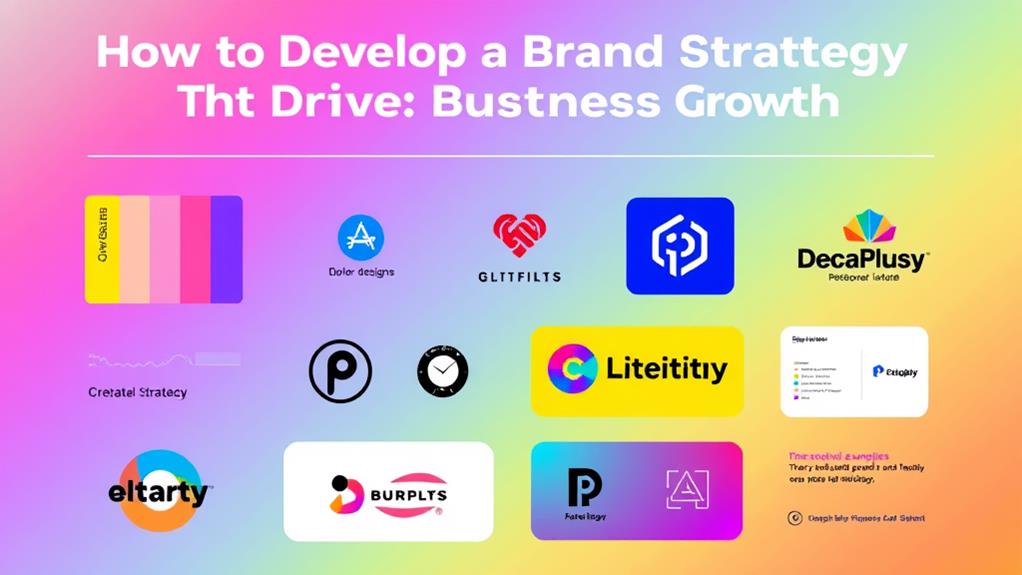How to Develop a Brand Strategy That Drives Business Growth
To develop a brand strategy that drives business growth, start by defining your brand purpose to establish emotional connections with your audience. Understand your target market through detailed segmentation, focusing on demographics and behavioral insights. Conduct a competitive analysis to identify market gaps and learn from competitors. Establish a consistent brand voice and visual identity to enhance recognition. Implement uniform messaging across all channels to solidify your brand's narrative. Finally, measure brand performance regularly to inform strategic adaptations. By prioritizing these elements, you'll create a sustainable brand that captivates customers and fosters loyalty, leading to enduring growth. Insights into effective methods await.
Key Takeaways
- Define a clear brand purpose that resonates with your target audience's values to foster emotional connections and guide strategic decisions.
- Conduct thorough market research to identify and understand your target audience's demographics and behavioral patterns for tailored messaging.
- Analyze competitors to identify gaps in the market and differentiate your brand through unique positioning and innovative strategies.
- Develop consistent brand voice and visual identity to enhance recognition, engagement, and trust across all communication platforms.
- Measure brand performance regularly to assess loyalty, engagement, and adapt strategies for sustainable growth in response to market trends.
Define Your Brand Purpose

Defining your brand purpose is a crucial step in establishing a strong foundation for business growth. A well-articulated brand purpose not only guides strategic decision-making but also aligns the organization around a common brand mission. It serves as the North Star, providing clarity to both internal stakeholders and external audiences about the essence of your brand.
At the core of your brand purpose lie your brand values—principles that embody your organization's identity and drive its actions. These values are non-negotiable; they dictate how your team interacts with customers, responds to challenges, and embraces opportunities.
For instance, if your brand values innovation, this should inform your product development and customer service strategies, ensuring they consistently reflect this commitment.
Moreover, a clearly defined brand purpose enhances emotional connections with your target audience. Customers today are increasingly discerning, often choosing brands that resonate with their personal values and aspirations.
Identify Your Target Audience
Understanding your target audience is a critical step in crafting a successful brand strategy.
By defining demographic characteristics, analyzing behavioral patterns, and segmenting the market effectively, businesses can tailor their messaging and offerings to resonate with specific consumer groups.
This strategic focus not only enhances engagement but also fosters loyalty, driving sustainable growth in an increasingly competitive landscape.
Define Demographic Characteristics
Identifying your target audience is a crucial step in shaping an effective brand strategy, as it allows businesses to tailor their messaging and offerings to specific consumer needs. An extensive understanding of demographic characteristics—such as age groups, income levels, and geographic regions—enables brands to position themselves effectively in the marketplace.
Furthermore, education backgrounds and lifestyle choices play critical roles in determining consumer preferences and purchasing habits. For instance, younger audiences may prioritize sustainability, while older demographics might focus on reliability and value.
Additionally, recognizing gender differences can help companies create targeted campaigns that resonate on a personal level. Cultural influences also shape preferences and behaviors, making it essential for brands to remain culturally aware and sensitive.
Analyzing social media usage across different demographic segments can further refine audience targeting, allowing businesses to engage effectively where their consumers spend the most time.
Ultimately, a thorough exploration into these factors offers insights that empower brands to craft compelling narratives and products that not only attract but also retain their ideal customers, driving sustained business growth.
Analyze Behavioral Patterns
Analyzing behavioral patterns is essential for businesses seeking to connect meaningfully with their target audience. By understanding consumer habits and purchase motivations, brands can tailor their strategies to resonate with potential customers. Emotional triggers play a pivotal role in decision making, as they influence how consumers perceive value and brand loyalty.
To effectively harness these insights, it is vital to examine online behavior and shopping preferences. Trend analysis allows businesses to identify emerging patterns, aligning their offerings with the evolving needs of consumers.
Additionally, social influences, such as peer recommendations and social media interactions, can greatly impact purchasing decisions, highlighting the importance of integrating these elements into brand strategies.
Feedback mechanisms, including surveys and customer reviews, provide valuable data that can refine understanding of consumer behavior. By leveraging this information, brands can create targeted marketing campaigns that resonate more deeply with their audience.
Ultimately, a thorough analysis of behavioral patterns empowers businesses to develop a brand strategy that not only attracts but also retains customers, driving sustained growth in a competitive marketplace.
Segment Market Effectively
Effective market segmentation serves as the backbone of a successful brand strategy, enabling businesses to pinpoint their ideal customer base with precision. By employing robust market segmentation strategies, organizations can categorize their audience based on demographics, psychographics, behaviors, and geographic locations.
This analytical approach not only identifies distinct customer segments but also reveals the underlying motivations that drive purchasing decisions.
Utilizing effective targeting techniques, brands can tailor their messaging and offerings to resonate with specific groups, enhancing engagement and loyalty. For instance, a luxury brand may segment its market by income levels, while a tech company could focus on early adopters versus mainstream users.
Moreover, understanding these segments allows for more efficient resource allocation, ensuring that marketing budgets are invested in high-potential areas.
This strategic alignment fosters a deeper connection with customers, facilitating personalized experiences that can differentiate a brand in a competitive landscape.
Conduct Competitive Analysis

Conducting a thorough competitive analysis is essential for understanding your market landscape and identifying key competitors.
By examining their market positioning, strengths, and weaknesses, businesses can uncover opportunities to differentiate themselves and enhance their brand strategy.
This analytical approach not only informs decision-making but also empowers organizations to leverage their unique value propositions effectively.
Identify Key Competitors
Regularly identifying key competitors is an essential step in the competitive analysis process, as it allows businesses to understand the landscape in which they operate. This identification is not merely about recognizing names; it involves a strategic approach to competitor benchmarking. By analyzing the strengths and weaknesses of competitors, businesses can uncover opportunities for market differentiation.
Start by categorizing competitors into direct and indirect groups. Direct competitors offer similar products or services, while indirect ones may fulfill the same customer need differently. A thorough assessment of their market positioning, branding strategies, customer engagement, and pricing models provides valuable insights.
Furthermore, evaluate competitors' customer feedback, social media presence, and marketing campaigns. This data not only illuminates potential gaps in your own strategy but also informs how to articulate unique selling propositions effectively.
Ultimately, understanding competitors enables businesses to craft a robust brand strategy that leverages distinct attributes, resonates with target audiences, and fosters long-term loyalty.
Analyze Market Positioning
Having identified key competitors, the next step involves a thorough analysis of market positioning to understand how these competitors differentiate themselves and appeal to their target audiences.
An effective competitive analysis should begin by examining current market trends and customer perception, as these elements shape brand equity and influence positioning strategies.
In evaluating the competitive landscape, it is essential to identify industry benchmarks that highlight successful differentiation tactics. By analyzing the value propositions of competitors, you can uncover what resonates with the target audience, ultimately revealing gaps in your own positioning.
This analysis can inform strategies to enhance brand loyalty and increase market share.
Furthermore, understanding how competitors communicate their unique selling points can enhance your own messaging. By leveraging insights into their approach, you can refine your brand's narrative to better align with customer expectations and preferences.
Assess Strengths and Weaknesses
Evaluating the strengths and weaknesses of your competitors is essential for crafting a robust brand strategy that propels business growth. Conducting a thorough brand audit through a SWOT analysis provides invaluable insights. This internal assessment not only highlights your competitors' strengths but also uncovers their vulnerabilities.
Utilize capability mapping to identify competitive advantages, focusing on areas where your brand can excel. Engage in resource evaluation to ascertain how competitors allocate their assets, thereby understanding their operational effectiveness. In doing so, you can perform a detailed risk assessment, recognizing potential threats posed by these rivals and positioning your brand to mitigate them.
Understanding market perception is critical; analyze how competitors communicate their value proposition and differentiate themselves within the marketplace. This information enables you to craft a compelling narrative around your brand differentiation strategy, ensuring that your offerings resonate with target audiences.
In essence, a meticulous assessment of competitors' strengths and weaknesses empowers you to refine your brand strategy, providing a clearer path to sustainable business growth and reinforcing your market position.
Develop Your Brand Voice
A well-defined brand voice serves as the foundation for effective communication and engagement with your target audience. Tone development is essential, as it shapes the emotional connection your brand establishes. This voice should reflect your brand's personality traits, whether authoritative, friendly, or innovative, and must resonate consistently across all communication channels.
To achieve language consistency, it is important to create a style guide that outlines key vocabulary, phrases, and tonal nuances. This guide guarantees that your messaging remains coherent, reinforcing your brand's identity and fostering trust among consumers.
By weaving brand storytelling into your communications, you can engage your audience more deeply, transforming them from passive viewers into active participants in your brand narrative.
Audience engagement hinges on authenticity expression; your brand voice must genuinely reflect your values and mission. This authenticity not only attracts your target demographic but also cultivates loyalty, as customers appreciate transparency and sincerity.
Additionally, consider the emotional impact of your language; powerful storytelling can evoke feelings that drive decision-making, reinforcing the bond between your brand and its audience.
Ultimately, developing your brand voice is an iterative process. Regularly assess how well your voice resonates with your audience and adapt as necessary.
Create a Visual Identity

How can a compelling visual identity transform your brand's perception in the marketplace? A well-crafted visual identity not only encapsulates your brand's essence but also considerably influences customer engagement and loyalty.
The interplay of color psychology, logo design, and typography selection creates an aesthetic appeal that speaks to your target audience, establishing a strong emotional resonance. The color palette you choose can evoke specific feelings—warm tones may invite comfort, while cool shades can indicate trust.
Similarly, a meticulously designed logo serves as the cornerstone of your brand's imagery, anchoring your visual narrative. Typography selection is equally vital; the font you choose should reflect your brand's personality, whether it's modern, traditional, or playful.
Incorporating graphic elements and brand imagery into your visual strategy enhances brand storytelling, allowing you to convey your mission and values visually. Effective visual consistency across all platforms guarantees that your audience recognizes and remembers your brand, reinforcing its identity in a crowded marketplace.
Furthermore, establishing a clear visual hierarchy directs attention to key messages and calls to action, making it easier for consumers to navigate and engage with your content.
Establish Brand Guidelines
Brand guidelines serve as the blueprint for maintaining a consistent and cohesive brand identity across all platforms and touchpoints. By clearly articulating standards for visual elements, typography, color schemes, and logo usage, these guidelines guarantee brand consistency that resonates with the audience. This consistency is paramount in fostering brand loyalty; it allows consumers to recognize and connect with your brand effortlessly, reinforcing their emotional connection.
Moreover, well-defined brand guidelines enhance brand storytelling, serving as a framework for how narratives are communicated across various communication channels. This storytelling not only aids in audience engagement but also strengthens market differentiation. In a time when consumers are inundated with choices, a distinct and authentic brand voice sets a business apart, making it more memorable and relatable.
In addition, brand guidelines encompass the tone and style of messaging, guaranteeing that every interaction contributes to a cohesive brand experience. This authenticity builds trust, encouraging consumers to engage with the brand repeatedly.
With a strong foundation in place, organizations can adapt their messaging to different platforms while maintaining a unified identity, thereby maximizing the impact of their marketing efforts.
Implement Consistent Messaging

Consistency in messaging is essential for establishing a strong brand presence in the marketplace. Brand consistency not only reinforces recognition but also shapes audience perception, creating an emotional connection that is pivotal for trust building. To achieve this, organizations must develop thorough messaging strategies that align with their brand guidelines and resonate across various communication channels.
A well-defined messaging framework serves as the backbone of brand storytelling, ensuring that every piece of communication reflects the core values and mission of the brand. This framework should encompass key messages, tone of voice, and stylistic elements, enabling cohesive narratives that engage and inspire.
By employing consistent messaging, brands can navigate different platforms—be it social media, advertising, or public relations—while maintaining a unified identity.
Moreover, delivering consistent messaging helps mitigate potential confusion among target audiences. When individuals encounter a brand's message repeatedly across diverse contexts, it solidifies their understanding and fosters familiarity. This familiarity, in turn, enhances emotional connection, as consumers begin to associate the brand with specific values and experiences.
Ultimately, implementing consistent messaging is not merely a tactical decision; it is a strategic imperative that influences brand loyalty and longevity. By committing to brand consistency and effectively utilizing messaging frameworks, organizations can cultivate a robust presence in the marketplace that drives business growth and fosters enduring relationships with their audience.
Measure Brand Performance
Effective brand messaging sets the stage for evaluating brand performance, as it establishes the benchmarks against which success can be measured. To truly gauge brand performance, businesses must explore various performance metrics that reflect brand equity and customer perception. These metrics not only quantify brand awareness but also inform organizations about the emotional connection they foster with their audience.
Key indicators of brand performance include brand loyalty and the impact of market trends on consumer behaviors. By analyzing customer engagement and retention rates, businesses can assess how effectively their brand resonates within the marketplace. Additionally, a robust digital presence is paramount; it serves as a conduit through which brands can cultivate relationships and monitor real-time feedback.
Equally important is reputation management, which encompasses the monitoring of social impact and public sentiment. Companies must remain vigilant in understanding how external factors influence customer perception and brand loyalty. Regularly evaluating customer feedback, social media discussions, and online reviews can provide invaluable insights into how your brand is perceived in the broader landscape.
Ultimately, measuring brand performance is not merely about collecting data; it requires a strategic interpretation of how these metrics reflect the brand's position in the market. By synthesizing insights from performance metrics with a focus on emotional connection and social impact, businesses can refine their strategies, ensuring they not only meet but exceed customer expectations in an ever-evolving environment.
Adapt and Evolve Your Strategy

In the dynamic landscape of modern business, the ability to adapt and evolve your strategy is essential for sustained growth and relevance. Brands must embrace brand agility, allowing them to pivot in response to shifting industry trends and market responsiveness.
This continual evolution is not merely reactive; it is an opportunity to proactively engage with customers and stakeholders, fostering deeper connections through collaborative branding initiatives.
To successfully adapt and evolve your brand strategy, consider the following:
- Leverage customer feedback to refine your offerings, guaranteeing they meet the evolving needs and preferences of your audience.
- Implement innovation strategies that encourage creativity and experimentation, positioning your brand as a leader in digital transformation.
- Monitor industry trends and cultural relevance to guarantee your messaging resonates in a way that builds brand loyalty.
- Enhance stakeholder engagement by maintaining open lines of communication, allowing for a more agile response to the market landscape.
The cornerstone of a successful brand strategy lies in its ability to integrate insights from customer interactions and industry shifts.
By prioritizing adaptability, businesses can not only survive but thrive amid uncertainties. A brand that embodies flexibility and responsiveness is more likely to cultivate lasting relationships, guaranteeing not only immediate success but also long-term sustainability.
In this ever-evolving marketplace, continuous adaptation is not just an option; it is a necessity for brands aiming to drive growth and maintain relevance.
Frequently Asked Questions
How Long Does It Take to See Brand Strategy Results?
The timeline for observing results from a brand strategy can vary considerably, typically ranging from three to twelve months.
Initial brand awareness may become evident within months, while market positioning often takes longer to solidify.
Consistent efforts in marketing, customer engagement, and brand messaging are vital.
Consequently, patience and strategic adjustments are essential for sustained growth, ensuring that the brand not only resonates with the target audience but also effectively differentiates itself in the competitive landscape.
What Budget Is Needed for a Comprehensive Brand Strategy?
In the intricate tapestry of brand development, understanding the costs associated with a thorough brand strategy is essential.
Budget allocation should encompass elements such as market research, creative design, and digital marketing efforts, typically ranging from 5% to 10% of projected revenue.
Investing wisely in these areas not only enhances brand visibility but also cultivates long-term loyalty, positioning your organization for sustainable growth and success in an increasingly competitive landscape.
Can I Develop a Brand Strategy Alone or Should I Hire Experts?
Developing a brand strategy independently can be feasible with a thorough self-assessment checklist to evaluate your strengths and weaknesses.
However, the benefits of expert consultation should not be underestimated, as seasoned professionals can provide valuable insights, industry trends, and innovative approaches that might not be apparent to a novice.
Ultimately, balancing self-driven efforts with expert guidance can lead to a more robust and effective brand strategy, fostering sustainable business growth.
How Often Should I Revisit My Brand Strategy?
Imagine a river, ever-flowing, adapting to its surroundings; similarly, your brand strategy requires regular assessment.
To guarantee alignment with brand evolution, revisiting your strategy at least annually is essential. This frequency allows for incorporation of market trends and stakeholder feedback while facilitating a competitive analysis.
What Tools Can Help in Measuring Brand Performance Effectively?
To measure brand performance effectively, leverage tools that focus on brand metrics, performance analysis, competitor benchmarking, and customer feedback.
Analytical platforms like Google Analytics provide insights into brand engagement, while social listening tools capture real-time customer sentiments.
Additionally, conducting surveys can yield qualitative feedback, enhancing your understanding of brand perception.
Regularly reviewing these metrics will enable you to adapt strategies, ensuring your brand remains competitive and resonates with your target audience.
Conclusion
To sum up, a robust brand strategy serves as the compass guiding business growth through the tumultuous waters of the marketplace. By meticulously defining brand purpose, understanding target audiences, and ensuring consistent messaging, the foundation for enduring success is established. As the brand evolves, its adaptability becomes the wind in its sails, propelling it toward new horizons. Ultimately, a well-crafted brand strategy not only differentiates a business but also cultivates lasting connections, transforming customers into loyal advocates.




